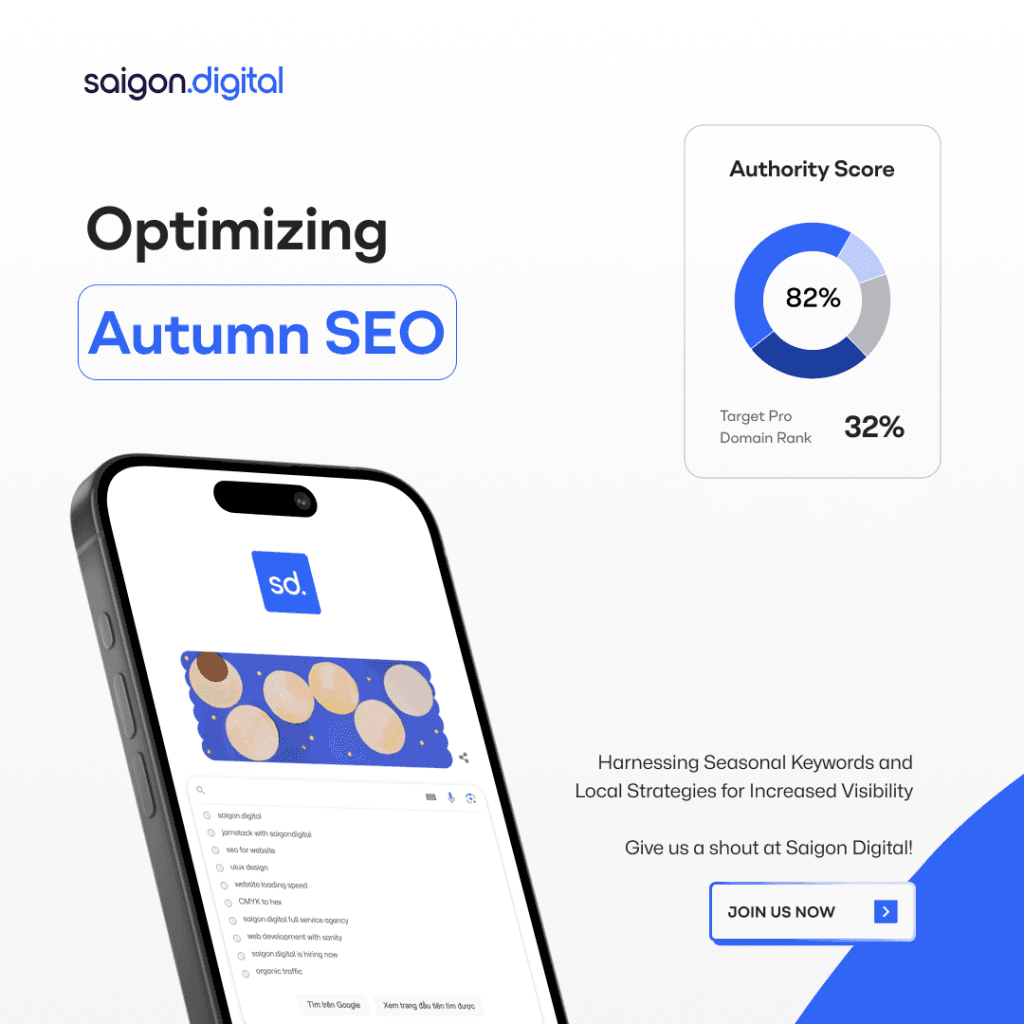As 2023 winds down, we're taking a peek at the SEO landscape to spot the trends that will shape the final quarter. From seasonal keywords to local SEO, we're breaking it all down in a digestible way. So, pull up a chair and let's dive into these 7 game-changing SEO trends for Q4 2023.
1. Seasonal Keywords
Just as you’d pack away your shorts and flip-flops to make room for cosy jumpers and wellies, your SEO keywords need a bit of a wardrobe change too. As we move through the year, our search habits change, just like our fashion choices. As a result, your keywords need to keep up with the times to ensure your website doesn’t lose its relevance.Seasonal keywords are a bit like the fashion trends of the internet. They're the buzzwords and phrases that become hot property during certain times of the year. For instance, in the summer months, folks might be tapping into Google, "best BBQ recipes" or "how to make iced tea". These are your summer keywords, the SEO equivalent of your shorts and flip-flops.Then, as the days start to get shorter and a chill fills the air, our online searches start to reflect this change. We swap our BBQs for slow cookers, and iced tea for hot cocoa. So, your keywords need to mirror this shift. "Comforting pumpkin soup recipes", "warm woolly jumpers", or "best hot drinks" might be the order of the day. These are your autumn keywords, the cosy jumpers and warm wellies of your SEO strategy.
Now, the trick here is not just to keep up with the changing seasons, but to stay one step ahead. Moreover, it's not just about the weather and holidays. Big events, cultural moments, and even popular TV shows can all trigger shifts in what people are searching for. The key is to stay nimble, keep your ear to the ground, and be ready to adapt your keywords to reflect the world around you.
So, as we brace ourselves for the final quarter of 2023, it's time to think about your own seasonal keywords.
2. Local SEO
As local communities become more cohesive, the importance of local SEO grows. People love supporting local businesses, and as the year ends, this becomes even more prevalent. At Saigon Digital, we specialise in Local SEO, assisting businesses in enhancing their brand recognition and expanding their reach.In a nutshell, local SEO helps your business stand out when people in your area search for the services you offer.To make your business shine locally:- Ensure NAP Consistency: NAP stands for Name, Address, and Phone number. Make sure these details are the same across all online platforms, helping search engines recognise your business.
- Encourage Customer Reviews: Ask your customers to leave reviews on platforms like Google. Respond to these reviews, showing that you value their feedback. This helps build your online reputation.
- Use Local Keywords: Include keywords related to your area in your website's content. You're not just a "cosy café" — you're a "cosy café in Manchester".
- Build Local Links: Connect with other local businesses and websites. The more you're mentioned locally, the more search engines see your local relevance.
3. Voice Search Optimisation
With the rise of virtual assistants like Siri, Alexa, and Google Assistant, voice search has become increasingly popular. In 2023, optimising your website for voice search will be essential to stay competitive. Voice search queries are often longer and more chatty, so focus on long-tail keywords and natural language in your content. Additionally, optimising your website for local search is crucial, as voice searches are often location-based.
The Rise of Voice Search
The rise of voice search is largely because of the increasing popularity of virtual assistants and smart speakers. These devices make it easy for users to perform searches by simply speaking, which is often more convenient than typing. As a result, more and more people are using voice search.
Keywords in voice search optimization can help your website rank higher in search results. This can lead to increased visibility and organic traffic. Moreover, voice search queries are often more specific and have a higher purchase intent compared to text-based searches. Therefore, optimising your website for voice search can also lead to higher conversion rates.
4. Mobile-first indexing
Mobile usage has surpassed desktop usage, making mobile-first indexing a top priority for SEO in 2023. Google now focuses on the mobile version of a website for indexing and ranking. To optimise for mobile-first indexing, ensure your website is mobile-friendly, loads quickly, and has a responsive design. Mobile optimisation also includes optimising images, reducing unnecessary pop-ups, and improving overall user experience on mobile devices.
Responsive Design: A Necessity, Not a Luxury In an age where mobile browsing has overtaken desktops, having a responsive website is critical. Responsive web design provides a seamless, optimal viewing experience across all devices by dynamically adjusting your website’s layoutAmid rising mobile usage, responsive design is vital for mobile-first indexing. It ensures your website seamlessly adapts to all devices, offering optimal viewing experiences by dynamically adjusting its layout.Google wants its search results to be relevant to mobile users, so it's making this a priority. Mobile optimization improves user experience, which can boost engagement and conversions. It also helps your site load faster, which Google values for ranking. Plus, it makes your site more accessible and visible to users.5. Core Web Vitals
Core Web Vitals are a set of metrics that measure the user experience of a website. In 2020, Google officially included Core Web Vitals in its ranking algorithm. These metrics include page loading speed, interactivity, and visual stability.
- Largest Contentful Paint (LCP) - measures loading performance;
- First Input Delay (FID) - measures interactivity; and
- Cumulative Layout Shift (CLS) - measures visual stability
To improve your website's Core Web Vitals, optimise your code, compress images, and minimise the use of third-party scripts. Providing a seamless user experience will not only improve your rankings but also increase user engagement and conversions.
6. High-Quality Content: More Than Just Words on a Page
The phrase "content is king" rings especially true in SEO, and as we approach Q4 of 2023, high-quality content remains a top trend. But what does high-quality content entail in the context of SEO?- Relevance: Relevant content is tailored to your audience's interests and needs. In SEO, this means using keywords that your audience is searching for, but in a meaningful context. Remember, search engines are becoming increasingly good at understanding content – so make it count!
- Engagement: Engaging content keeps readers on your page longer. This can signal to search engines that your content is valuable, which could boost your ranking. Use a compelling tone, ask questions, and encourage interaction to keep your readers engaged.
- Value: Valuable content provides useful information or solutions. In SEO terms, this value can translate into backlinks, as other sites link to your useful content, and social shares, as readers share your content with others. Both backlinks and social shares can positively impact your SEO.
7. B2B SEO Trends
B2B SEO focuses on targeting businesses and professionals rather than individual consumers. Account-based marketing (ABM) will play a crucial role in B2B SEO, as it allows for personalised and targeted marketing campaigns. Moreover, ABM can lead to higher conversion rates, as personalised campaigns are often more effective than generic ones.
Additionally, optimising for industry-specific keywords and creating valuable content for decision-makers in the B2B space will be essential.
Understanding B2B SEO
Unlike B2C SEO, which focuses on individual consumers, B2B SEO focuses on businesses and professionals. This means that we use different keywords, content, and marketing strategies compared to B2C SEO.- For instance, focus on industry-specific keywords and create content tailored to address the concerns of B2B decision-makers.
Conclusion
So, there you have it - the 7 SEO trends that'll be making waves in Q4 of 2023.
Staying informed and adapting your SEO strategy to these trends is essential. But remember, SEO isn't one-size-fits-all. It's not just about ranking higher; it's about providing better user experiences and driving conversions in an ever-competitive digital landscape. Fancy seeing how these trends could work for you? Don't be shy - give us a bell at Saigon Digital, and let's get your SEO strategy shipshape for the season.





